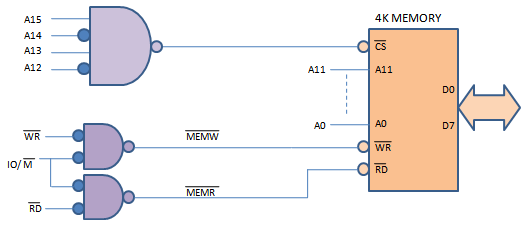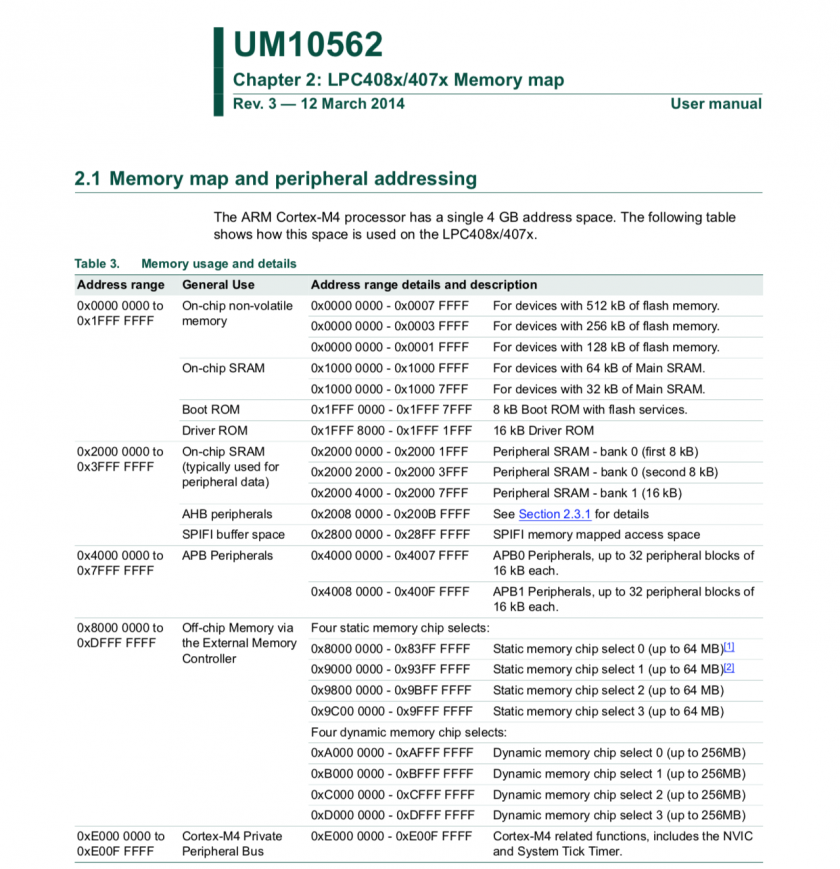LPC40xx MCU Memory Map
What is a Memory Map
A memory map is a layout of how the memory maps to some set of information. With respect to embedded systems, the memory map we are concerned about maps out where the Flash (ROM), peripherals, interrupt vector table, SRAM, etc are located in address space.
Memory mapped IO
Memory mapped IO is a means of mapping memory address space to devices external (IO) to the CPU, that is not memory.
For example (assuming a 32-bit system)
- Flash could be mapped to address 0x00000000 to 0x00100000 (1 Mbyte range)
- GPIO port could be located at address 0x1000000 (1 byte)
- Interrupt vector table could start from 0xFFFFFFFF and run backwards through the memory space
- SRAM gets the rest of the usable space (provided you have enough SRAM to fill that area)
It all depends on the CPU and the system designed around it.
Port Mapped IO
Port mapped IO uses additional signals from the CPU to qualify which signals are for memory and which are for IO. On Intel products, there is a (~M/IO) pin that is LOW when selecting MEMORY and HIGH when it is selecting IO.
The neat thing about using port mapped IO, is that you don't need to sacrifice memory space for IO, nor do you need to decode all 32-address lines. You can limit yourself to just using 8-bits of address space, which limits you to 256 device addresses, but that may be more than enough for your purposes.

Figure 2. Address Decoding with port map
(http://www.dgtal-sysworld.co.in/2012/04/memory-intercaing-to-8085.html)
LPC40xx memory map
Figure 3. LPC40xx Memory Map
From this you can get an idea of which section of memory space is used for what. This can be found in the UM10562 LPC40xx user manual. If you take a closer look you will see that very little of the address space is actually taken up. With up to 4 billion+ address spaces (because 2^32 is a big number) to use you have a lot of free space to spread out your IO and peripherals.
Reducing the number of lines needed to decode IO
The LPC40xx chips, to reduce bus line count, make all the peripherals 32-bit word aligned. Which means you must grab 4-bytes at a time. You cannot grab a single byte (8-bits) or a half-byte (16-bits) from memory. This eliminates the 2 least significant bits of address space.
Accessing IO using Memory Map in C
Please read the following code snippet. This is runnable on your system now. Just copy and paste it into your main.c file.
/*
The goal of this software is to set the GPIO pin P1.0 to
low then high after some time. Pin P1.0 is connected to an LED.
The address to set the direction for port 1 GPIOs is below:
DIR1 = 0x20098020
The address to set a pin in port 1 is below:
PIN1 = 0x20098034
*/
#include <stdint.h>
volatile uint32_t * const DIR1 = (uint32_t *)(0x20098020);
volatile uint32_t * const PIN1 = (uint32_t *)(0x20098034);
int main(void)
{
// Set 0th bit, setting Pin 0 of Port 1 to an output pin
(*DIR1) |= (1 << 0);
// Set 0th bit, setting Pin 0 of Port 1 to high
(*PIN1) |= (1 << 0);
// Loop for a while (volatile is needed!)
for(volatile uint32_t i = 0; i < 0x01000000; i++);
// Clear 0th bit, setting Pin 0 of Port 1 to low
(*PIN1) &= ~(1 << 0);
// Loop forever
while(1);
return 0;
}volatile keyword tells the compiler not to optimize this variable out, even if it seems useless
const keyword tells the compiler that this variable cannot be modified
Notice "const" placement and how it is placed after the uint32_t *. This is because we want to make sure the pointer address never changes and remains constant, but the value that it references should be modifiable.
Using the LPC40xx.h
The above is nice and it works, but it's a lot of work. You have to go back to the user manual to see which addresses are for what register. There must be some better way!!
Take a look at the lpc40xx.h file, which It is located in the sjtwo-c/projects/lpc40xx_freertos/lpc40xx.h. Here you will find definitions for each peripheral memory address in the system.
Let's say you wanted to port the above code to something a bit more structured:
- Open up "lpc40xx.h"
- Search for "GPIO"
- You will find a struct with the name LPC_GPIO_TypeDef.
- Now search for "LPC_GPIO_TypeDef" with a #define in the same line.
- You will see that LPC_GPIO_TypeDef is a pointer of these structs
#define LPC_GPIO0 ((LPC_GPIO_TypeDef *) LPC_GPIO0_BASE )#define LPC_GPIO1 ((LPC_GPIO_TypeDef *) LPC_GPIO1_BASE )#define LPC_GPIO2 ((LPC_GPIO_TypeDef *) LPC_GPIO2_BASE )#define LPC_GPIO3 ((LPC_GPIO_TypeDef *) LPC_GPIO3_BASE )#define LPC_GPIO4 ((LPC_GPIO_TypeDef *) LPC_GPIO4_BASE )
- We want to use LPC_GPIO1 since that corresponds to the GPIO port 1.
- If you inspect LPC_GPIO_TypeDef, you can see the members that represent register DIR and PIN
- You can now access DIR and PIN registers in the following way:
#include "lpc40xx.h"
int main(void)
{
// Set 0th bit, setting Pin 0 of Port 1 to an output pin
LPC_GPIO1->DIR |= (1 << 0);
//// Set 0th bit, setting Pin 0 of Port 1 to high
LPC_GPIO1->PIN |= (1 << 0);
//// Loop for a while (volatile is needed!)
for(volatile uint32_t i = 0; i < 0x01000000; i++);
//// Clear 0th bit, setting Pin 1.0 to low
LPC_GPIO1->PIN &= ~(1 << 0);
//// Loop forever
while(1);
return 0;
}At first this may get tedious, but once you get more experience, you won't open the lpc40xx.h file very often. This is the preferred way to access registers in this course and in industry.
On occasions, the names of registers in the user manual are not exactly the same in this file.

